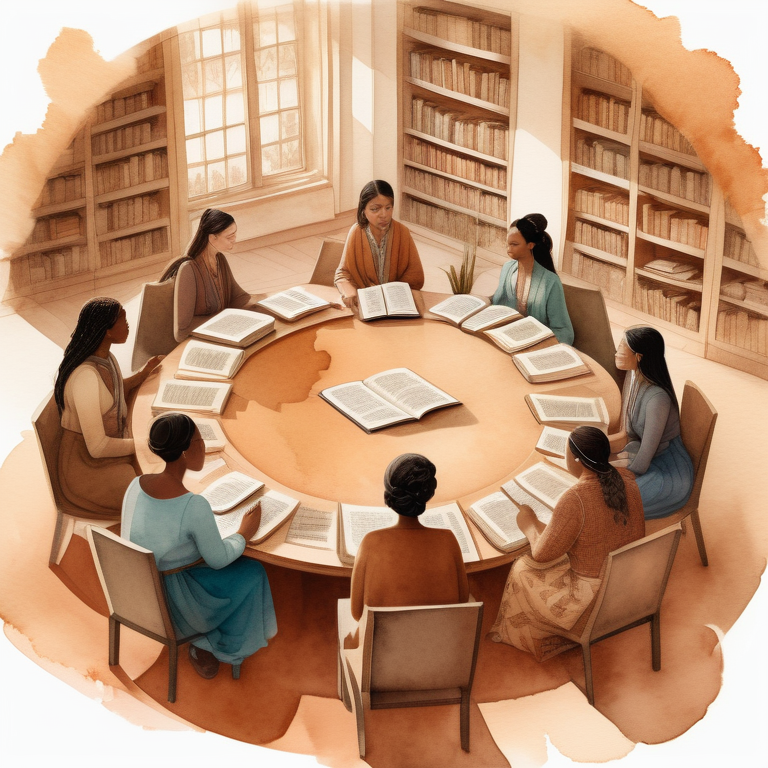Exploring Cross-Cultural Studies in Female Sexuality

Key Highlights
- Cross-cultural studies provide valuable insights into the diversity of female sexuality across different societies.
- Culture plays a significant role in shaping sexual norms and attitudes towards female sexuality.
- Historical research in female sexuality has paved the way for a better understanding of sexual norms and practices.
- Methodologies used in cross-cultural studies of female sexuality include qualitative and quantitative approaches.
- Gender roles and societal expectations have a profound impact on women’s sexual autonomy.
- The impact of globalization and digital age on female sexuality is a growing area of study.
Introduction
Cross-cultural studies in female sexuality offer a unique perspective on the diversity and complexity of women’s experiences across different societies. By examining the role of culture in shaping sexual norms, these studies provide valuable insights into the various factors that influence female sexuality. This blog explores the field of cross-cultural studies in female sexuality, delving into the historical overview, methodologies used, and case studies from diverse cultures. It also discusses the impact of gender roles, globalization, and legal and social frameworks on female sexuality. Let’s delve deeper into the fascinating world of cross-cultural studies in female sexuality and gain a better understanding of the complexities and nuances that shape women’s sexual experiences across the globe.
Understanding Cross-Cultural Perspectives on Female Sexuality
Cross-cultural perspectives on female sexuality allow us to examine how different societies and cultures shape sexual norms and attitudes towards women’s sexuality. By studying the cultural, historical, and social factors that influence female sexuality, we can gain a deeper understanding of the diverse experiences and challenges faced by women around the world. These studies shed light on the impact of gender roles, societal expectations, and cultural practices on women’s sexual autonomy and well-being. Understanding cross-cultural perspectives on female sexuality is essential for promoting gender equality, challenging stereotypes, and creating more inclusive and empowering sexual health care for women.
The Role of Culture in Shaping Sexual Norms
Culture plays a significant role in shaping sexual norms and attitudes towards female sexuality. Different societies have varying beliefs, values, and practices when it comes to women’s sexual expression and autonomy. Gender roles, societal expectations, and cultural traditions influence how women’s sexuality is perceived and regulated. For example, in some cultures, women are expected to be modest and conform to traditional gender roles, while in others, they may have more freedom to explore their sexual desires. These cultural differences can contribute to disparities in women’s sexual health, access to reproductive healthcare, and gender equality. By studying cross-cultural perspectives on female sexuality, we can gain insights into the diverse ways in which culture impacts women’s sexual experiences and work towards creating a more inclusive and equitable society for all women.
Comparative Analysis of Female Sexuality Across Societies
In exploring female sexuality across societies, it becomes evident that cultural norms significantly influence attitudes and behaviors. Comparing these norms reveals varying perspectives on women’s sexual agency and expression. Gender roles, as defined by each society, shape expectations and boundaries related to sexuality. Understanding these differences is crucial in promoting gender equality and addressing disparities in sexual health outcomes. By delving into comparative studies, researchers shed light on the complexity of female sexuality within diverse sociocultural contexts.
Historical Overview of Female Sexuality Studies
Pioneering research in the field of female sexuality studies has significantly shaped modern understandings. From early explorations to the evolution of theoretical frameworks, scholars have delved into the intricate dynamics of cross-cultural perspectives. These studies have provided valuable insights into the role of culture in shaping sexual norms and behaviors, paving the way for a more nuanced understanding of gender roles and differences across different societies.
Pioneering Research and Its Impact on Modern Understandings
Pioneering research in cross-cultural studies of female sexuality has laid the foundation for modern understandings in the field. Early scholars delved into the intricacies of gender differences and gender roles across different countries, shaping contemporary perspectives on women’s sexual health. Their work, recognized by influential bodies like the World Health Organization and APA, has been instrumental in advancing gender equality through social sciences. This groundwork established crucial methodologies and theoretical frameworks that continue to guide current research efforts.
Evolution of Theoretical Frameworks in Cross-Cultural Studies
The evolution of theoretical frameworks in cross-cultural studies of female sexuality has been a fascinating journey, shaped by diverse perspectives and methodologies. Scholars have moved beyond simplistic comparisons to embrace the complexity of gender roles and differences across different countries. Organizations like the World Health Organization emphasize the importance of understanding gender equality and social inequalities. Researchers using methodologies endorsed by APA or PMC continue to contribute valuable insights into women’s experiences across cultures.
Methodologies in Cross-Cultural Studies of Female Sexuality
Examining methodologies in cross-cultural studies of female sexuality involves navigating diverse approaches. From qualitative exploration to quantitative surveys, researchers utilize varying tools to analyze gender differences across different countries. Ethical considerations, as outlined by APA and other bodies, play a pivotal role in ensuring the integrity of such studies. SAGE and PMC publications often highlight key findings in this realm, shedding light on the complexities of gender roles and sexuality within various societies.
Qualitative vs. Quantitative Approaches
When examining Cross-Cultural Studies in Female Sexuality, researchers use qualitative and quantitative approaches to gather data. Qualitative methods delve into the nuances and subjective experiences, offering rich insights into cultural contexts. On the other hand, quantitative approaches rely on numerical data and statistical analysis to draw comparisons across different societies. Both methodologies play crucial roles in understanding the complexities of female sexuality within diverse cultural settings, providing a comprehensive view of gender differences and societal norms.
Ethical Considerations in Sexuality Research
Ethical considerations are paramount in sexuality research, particularly in cross-cultural studies. Researchers must prioritize the well-being and rights of participants, ensuring informed consent, confidentiality, and protection from harm. Cultural sensitivity is crucial, as cultural norms and practices may differ significantly across societies. The World Health Organization provides guidelines for conducting ethical research on sensitive topics, including sexuality. Researchers must navigate potential power imbalances and ensure that participants are not coerced into sharing personal information. In cross-cultural studies, researchers must also consider the potential impact of their research on the communities they study and strive for equitable and respectful collaborations. By adhering to ethical principles, researchers can conduct rigorous and responsible cross-cultural studies that contribute to a better understanding of female sexuality while respecting the rights and dignity of participants.
Case Studies from Diverse Cultures
Sexuality and womanhood in Eastern cultures present intriguing contrasts to Western perspectives. Indigenous views on female sexuality, deeply rooted in tradition, offer valuable insights. Understanding these diverse cultural approaches enhances our grasp of gender differences in sexual expression. By examining specific cases from various countries, we can glean profound insights into the intricate interplay between culture, gender roles, and sexual norms. These case studies underscore the importance of considering cultural contexts in cross-cultural studies of female sexuality.
Sexuality and Womanhood in Eastern Cultures
In Eastern cultures, the intertwining of sexuality and womanhood is often deeply rooted in traditions and societal expectations. Gender roles play a significant role in shaping attitudes towards female sexuality, influencing everything from expression to autonomy. Varied perceptions exist on gender differences concerning sexuality, reflecting a complex interplay between cultural norms and individual experiences. Understanding these nuances is crucial for achieving gender equality and promoting comprehensive healthcare solutions, as highlighted by the World Health Organization and social sciences research.
Indigenous Perspectives on Female Sexuality
Indigenous perspectives on female sexuality offer rich insights into the intersection of culture and sexual norms. These unique viewpoints, often rooted in traditional practices and beliefs, shed light on the diversity of experiences across different societies. Understanding indigenous perspectives is essential in fostering a more inclusive approach to studying and appreciating the complexities of female sexuality globally. By examining these insights, researchers can gain a deeper understanding of the nuanced dynamics at play within cultural contexts.
Gender Roles and Sexual Expression
Gender roles play a significant role in shaping women’s sexual expression and autonomy. Societal expectations and cultural norms influence how women are socialized to view their bodies, desires, and sexual agency. Gender roles may restrict or encourage women’s exploration of their sexuality, affecting their ability to express their desires and negotiate their sexual relationships. Traditional gender roles often reinforce stereotypes and perpetuate gender inequalities, limiting women’s sexual autonomy and reinforcing societal power imbalances. By studying the impact of gender roles on women’s sexual expression, researchers can challenge gender norms and work towards creating a more equitable and empowering society for all women.
Influence of Gender Norms on Sexual Autonomy
Gender norms have a significant influence on women’s sexual autonomy, shaping their ability to make choices about their bodies, desires, and sexual relationships. Societal expectations and cultural beliefs about gender roles often limit women’s sexual agency, reinforcing traditional gender binaries that prioritize male desires and control over female sexuality. Gender norms may dictate what is considered “acceptable” or “appropriate” sexual behavior for women, imposing restrictions and expectations that can hinder women’s sexual exploration and expression. Challenging these gender norms and promoting gender equality is crucial for promoting women’s sexual autonomy and well-being. By studying the influence of gender norms on sexual autonomy, researchers can contribute to the development of interventions and policies that promote gender equality and empower women to make informed choices about their bodies and sexuality.
Deconstructing the Gender Binary in Cross-Cultural Contexts
Deconstructing the gender binary is an important aspect of cross-cultural studies in female sexuality. The gender binary refers to the classification of individuals into either male or female, based on biological sex. However, many cultures recognize and honor diverse gender identities and expressions beyond the traditional male-female binary. By studying cross-cultural perspectives on gender, researchers can challenge the notion that gender is fixed and explore the diverse ways in which individuals experience and express their gender identities. This deconstruction of the gender binary is crucial for promoting inclusivity and understanding the complexities of gender in relation to sexuality. It highlights the need for more inclusive and affirming approaches to gender and sexuality that recognize and respect all individuals’ unique experiences and identities.
The Impact of Globalization on Female Sexuality
Globalization has had a profound impact on female sexuality, influencing cultural attitudes, practices, and norms related to sex and sexuality. Increased interconnectedness and exposure to different cultures through media, technology, and travel have led to a blending and exchange of ideas and values. This globalization of ideas and information has both positive and negative effects on women’s sexual experiences. On one hand, it can contribute to a more open and inclusive understanding of sexuality. On the other hand, it can perpetuate harmful stereotypes and reinforce gender inequalities. By studying the impact of globalization on female sexuality, researchers can gain insights into the complex ways in which cultural globalization influences women’s sexual identities, behaviors, and well-being.
Western Influences and Resistance in Non-Western Cultures
Western influences on non-Western cultures have had a significant impact on female sexuality. As Western ideas and values spread through globalization, they often clash with existing cultural norms and traditions. This clash can lead to resistance and a reaffirmation of traditional values and practices, particularly in relation to female sexuality. Some non-Western cultures perceive Western values as a threat to their cultural identity and may resist the adoption of more liberal attitudes towards female sexuality. Studying the interplay between Western influences and resistance in non-Western cultures provides insights into the complexities of cultural change and the ways in which women navigate and negotiate their sexual identities in a globalized world.
Digital Age and its Role in Redefining Sexuality
The digital age has revolutionized the way we communicate, access information, and engage with the world, including our understanding and expression of sexuality. Social media platforms, online dating apps, and the availability of sexual content online have reshaped cultural attitudes and practices related to female sexuality. Women now have unprecedented access to information, support networks, and opportunities for sexual exploration and expression. However, the digital age also presents challenges, such as cyberbullying, online harassment, and the perpetuation of harmful stereotypes and unrealistic beauty standards. By examining the role of the digital age in redefining sexuality, researchers can gain insights into the ways in which technology influences women’s sexual experiences and well-being.
Legal and Social Frameworks Affecting Female Sexuality
Legal and social frameworks play a crucial role in shaping women’s sexual autonomy and well-being. Laws and policies related to reproductive rights, consent, sexual education, and gender equality significantly impact women’s sexual health and rights. Social norms and attitudes towards female sexuality can either empower or restrict women’s sexual agency. By studying the intersection of legal and social frameworks with female sexuality, researchers can identify gaps, challenges, and opportunities for promoting gender equality, challenging gender stereotypes, and creating more inclusive and empowering sexual health care for women. This research informs the development of evidence-based interventions and policies that support women’s sexual well-being and autonomy.
Rights, Laws, and Female Sexual Autonomy
Women’s sexual autonomy is strongly influenced by legal and human rights frameworks. Laws and policies related to reproductive rights, consent, and gender equality impact women’s ability to make choices about their bodies, desires, and sexual relationships. Ensuring women’s sexual autonomy requires the protection of their rights to bodily integrity, reproductive health, and freedom from discrimination and violence. By examining the legal frameworks that govern female sexuality and identifying barriers and gaps in these frameworks, researchers can contribute to the development of policies and interventions that promote gender equality, challenge harmful gender norms, and protect and empower women’s sexual autonomy.
Socio-Political Movements and Their Influence
Socio-political movements have played a crucial role in shaping attitudes towards female sexuality and promoting gender equality. Movements for women’s rights, LGBTQ+ rights, and sexual liberation have challenged traditional norms and advocated for more inclusive and empowering approaches to sexuality. These movements have pushed for changes in laws, policies, and societal attitudes, aiming to create a more equitable and just society for all individuals. By studying the influence of socio-political movements on female sexuality, researchers can gain insights into the power of collective action and grassroots organizing in transforming cultural norms and promoting gender equality. This research contributes to a better understanding of the complex interplay between social change, activism, and women’s sexual well-being.
Conclusion
In conclusion, exploring cross-cultural studies in female sexuality unveils a rich tapestry of diverse perspectives and norms. By understanding the historical, cultural, and societal influences on female sexuality, we gain valuable insights into gender roles, autonomy, and expression across different societies. As we navigate through the complexities of globalization and legal frameworks, it becomes evident that a nuanced approach is essential in reshaping perceptions and promoting inclusivity. Embracing the evolution of theoretical frameworks and methodologies, we pave the way for more comprehensive research and informed discussions on this vital subject. Let’s continue this dialogue and share our learnings on social media to foster a deeper understanding of female sexuality worldwide.
Frequently Asked Questions
What are common misconceptions about female sexuality in cross-cultural studies?
Common misconceptions about female sexuality in cross-cultural studies include assuming that all women have the same experiences and attitudes towards sex, ignoring the influence of culture and societal norms, and generalizing findings from one culture to another. Cross-cultural studies highlight the diversity and complexity of female sexuality across different societies and challenge these misconceptions.
How do social media and globalization affect perceptions of female sexuality?
Social media and globalization have had a profound impact on perceptions of female sexuality. They have increased access to information, created new platforms for sexual expression, and facilitated the spread of diverse perspectives on sexuality. However, they have also perpetuated harmful stereotypes and unrealistic beauty standards, leading to negative impacts on women’s self-image and sexual well-being.
Can cross-cultural studies contribute to more inclusive sexual education programs?
Yes, cross-cultural studies can contribute to more inclusive sexual education programs by providing insights into the diverse experiences and attitudes towards sexuality across different cultures. This understanding can inform the development of culturally sensitive and relevant sexual education materials that promote gender equality, respect diversity, and empower individuals to make informed choices about their sexual health.
What future directions can research in cross-cultural studies of female sexuality take?
Future research in cross-cultural studies of female sexuality can explore the intersections of gender, race, and sexuality, examine the impact of globalization on marginalized communities, and focus on understanding and addressing disparities in sexual health outcomes. It can also explore the ways in which cultural practices and traditions influence women’s sexual experiences and well-being.





